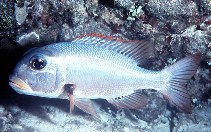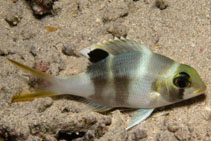Monotaxis grandoculis (Forsskål, 1775)
Humpnose big-eye bream
個人による観察記録の追加 Fish Watcher
| Native range | All suitable habitat | Point map | Year 2050 |

|
| This map was computer-generated and has not yet been reviewed. |
| Monotaxis grandoculis AquaMaps Data sources: GBIF OBIS |
Saudi Arabia country information
Common names:
[No common name]
Occurrence: native
Salinity: marine
Abundance: | Ref:
Importance: | Ref:
Aquaculture: | Ref:
Regulations: | Ref:
Uses: no uses
Comments:
National Checklist:
Country Information: https://www.cia.gov/library/publications/resources/the-world-factbook/geos/sa.html
National Fisheries Authority:
Occurrences: Occurrences Point map
Main Ref: Carpenter, K.E. and G.R. Allen, 1989
National Database:
Occurrence: native
Salinity: marine
Abundance: | Ref:
Importance: | Ref:
Aquaculture: | Ref:
Regulations: | Ref:
Uses: no uses
Comments:
National Checklist:
Country Information: https://www.cia.gov/library/publications/resources/the-world-factbook/geos/sa.html
National Fisheries Authority:
Occurrences: Occurrences Point map
Main Ref: Carpenter, K.E. and G.R. Allen, 1989
National Database:
Common names from other countries
分類 / Names 共通名の | 類義語 | Catalog of Fishes(部類, 種) | ITIS | CoL | WoRMS | Cloffa
> Eupercaria/misc (Various families in series Eupercaria) > Lethrinidae (Emperors or scavengers) > Monotaxinae
Etymology: Monotaxis: Greek, monos = one + Greek, taxis = disposition (Ref. 45335).
More on author: Forsskål.
Etymology: Monotaxis: Greek, monos = one + Greek, taxis = disposition (Ref. 45335).
More on author: Forsskål.
Environment: milieu / climate zone / depth range / distribution range 生態学
海 関連する礁; 移住性ではない; 深さの範囲 0 - 100 m (Ref. 9710), usually 5 - 30 m (Ref. 9775). Tropical; 35°N - 30°S, 32°E - 122°W
分布 国々 | 国連食糧農業機関の区域 | エコシステム | 事件 | Point map | 導入 | Faunafri
Indo-Pacific: Red Sea and East Africa to the Hawaiian Islands and southeastern Oceania, north to Japan, south to Australia.
Length at first maturity / サイズ / 重さ / 年齢
Maturity: Lm 30.3, range 18 - ? cm
Max length : 60.0 cm TL オス/雌雄の選別がない; (Ref. 2295); common length : 40.0 cm TL オス/雌雄の選別がない; (Ref. 2295); 最大公表体重: 5.9 kg (Ref. 40637)
Max length : 60.0 cm TL オス/雌雄の選別がない; (Ref. 2295); common length : 40.0 cm TL オス/雌雄の選別がない; (Ref. 2295); 最大公表体重: 5.9 kg (Ref. 40637)
簡単な記述 検索表 | 形態学 | 形態計測学
背面の脊椎 (合計) : 10; 背鰭 (合計) : 10; 肛門の骨: 3; 臀鰭: 9. This species is distinguished by the following characters: body oblong, greatest body depth of adults about 2.2 in SL; head profile strongly convex in front of eye, the snout sloping steeply; eye large 2.7 (juveniles) to 3.8 (adults) in HL; inner surface of the pectoral fin base is densely scaled; pectoral rays usually 14; caudal fin forked with pointed tips; lateral line scales 44-47; scale rows above lateral line (to base of middle dorsal spines) 5, below (to origin of anal fin) 13.5; side of jaw with row of 5-7 molariform teeth. Color of adult silvery grey with narrow dark scale margins, lips yellowish, a large black blotch covering pectoral fin axil, quick to assume pattern of 4 broad, blackish bars on body, the pale interspaces covering 3-4 scale rows; juveniles with black bar through eye, body with 3 dark brown to blackish bars with the 2 posterior bars extending onto the dorsal fin, and each lobe of caudal fin with an orange band (Ref. 2295, 90102).
Found in sand and rubble areas near coral reefs. Solitary fish are often encountered, but large adults usually form aggregations of up to about 50 individuals (Ref. 9710). Solitary or in groups (Ref. 90102). Benthopelagic (Ref. 58302). Nocturnal feeders (Ref. 9710). Feed mainly on gastropods, ophiuroids, and echinoids. Pagurids and brachyuran crabs, polychaetes, tunicates, and holothurians are consumed in lesser quantities. Caught mainly with gillnets, traps, spears, and handlines (Ref. 2295). Marketed fresh (Ref. 9775). Ciguatoxic in Marshall Is. (Ref. 171). Minimum depth reported taken from Ref. 128797.
Life cycle and mating behavior 成熟 | 繁殖 | 放精 | 卵 | 生産力 | 幼生
主な参考文献
Upload your references | 参考文献 | コーディネーター | 協力者
Carpenter, K.E. and G.R. Allen, 1989. FAO Species Catalogue. Vol. 9. Emperor fishes and large-eye breams of the world (family Lethrinidae). An annotated and illustrated catalogue of lethrinid species known to date. FAO Fish. Synop. 125(9):118 p. Rome: FAO. (Ref. 2295)
Human uses
水産業: 商業; ゲームフィッシュ: はい; 水族館・水槽: 商業
FAO(水産業: 代謝; publication : search) | FishSource | 私達の周りの海
より多くの情報
Population dynamics
成長のパラメーター
Max. ages / sizes
Length-weight rel.
Length-length rel.
体長組成
Mass conversion
補充
豊度
成長のパラメーター
Max. ages / sizes
Length-weight rel.
Length-length rel.
体長組成
Mass conversion
補充
豊度
Physiology
Body composition
Nutrients
酸素消費
水泳形態
泳ぐ速さ
Visual pigments
Fish sound
Diseases & Parasites
Toxicity (LC50s)
Body composition
Nutrients
酸素消費
水泳形態
泳ぐ速さ
Visual pigments
Fish sound
Diseases & Parasites
Toxicity (LC50s)
Genetics
遺伝子の
Heterozygosity
遺伝
遺伝子の
Heterozygosity
遺伝
用具
Bio-Quiz | E-book | 野外観察図鑑 | 検索表 | Length-frequency wizard | 生活史の基盤ツール | 目的のマップ | Classification Tree
| Catch-MSY |
特記事項
XMLをダウンロードして下さい
インターネットの情報源
Aquatic Commons | BHL | Cloffa | BOLDSystems | Websites from users | Check FishWatcher | CISTI | Catalog of Fishes(部類, 種) | DiscoverLife | ECOTOX | Faunafri | Fishtrace | GenBank(ゲノム, ヌクレオチド) | GloBI | GOBASE | | Google Books | Google Scholar | Google | IGFA World Record | MitoFish | 国のデーターベース | Otolith Atlas of Taiwan Fishes | PubMed | Reef Life Survey | Scirus | SeaLifeBase | 生命の木 | Wikipedia(行く, 検索する) | World Records Freshwater Fishing | 動物に関する記録
Estimates based on models
Preferred temperature (Ref. 115969): 24.6 - 29.1, mean 28 (based on 1440 cells).
Phylogenetic diversity index (Ref. 82804): PD50 = 0.7500 [Uniqueness, from 0.5 = low to 2.0 = high].
Bayesian length-weight: a=0.01950 (0.01525 - 0.02494), b=2.98 (2.91 - 3.05), in cm Total Length, based on LWR estimates for this species (Ref. 93245).
栄養段階 (Ref. 69278): 3.4 ±0.0 se; based on diet studies.
回復力 (Ref. 120179): 手段, 1.4年~4.4年の倍増期間の最小個体群 (Preliminary K or Fecundity.).
Fishing Vulnerability (Ref. 59153): Moderate vulnerability (40 of 100).
Climate Vulnerability (Ref. 125649): Very high vulnerability (76 of 100).





